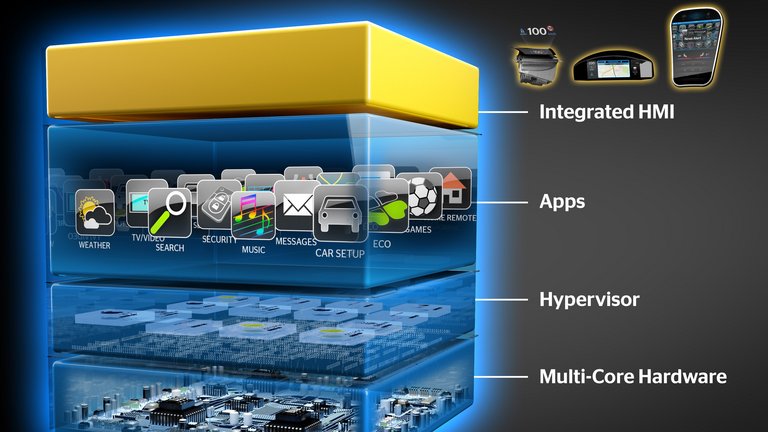Higher System Integration in the Vehicle Cockpit
- Technology to integrate control electronics for instrument clusters and infotainment systems prior to series production readiness
- Hypervisor virtualization, which has been successfully used in the aviation industry, brings together different software worlds with diverging requirements onto one hardware system
- From instrument clusters and multimedia to consumer electronics: user-friendly operation on the road to a holistic human-machine interface
Babenhausen, 25 February 2014. Today, ever more electronics systems run together in the cockpits of modern vehicles. These include a growing number of vehicle systems, multimedia applications, the booming world of the Internet, the Cloud and mobile entertainment technology. With a process for integrating the different system worlds in a single vehicle domain, Continental shows that more software and cross-linking does not necessarily have to lead to more hardware. At the Embedded World trade fair in Nuremberg (25-27 February, Sysgo booth, 5-371) visitors will be able to see how comfortably different electronics systems can be operated if they are integrated on one hardware system. "Through the use of Hypervisor technology, different software worlds with varying requirements can be brought together on one set of hardware," explains Ralf Lenninger, Head of Strategy and System Development at Continental Division Interior. "This is useful from the point of view of systems and ergonomics, since the borders between different applications in the cockpit are becoming increasingly blurred due to cross-linking." For the sake of clarity however, a holistic human-machine interface is needed. In the domain integration developed for this, several displays and software worlds are now coordinated from one hardware system. "This means there is always a familiar structure in front of the driver, making operation easier," Lenninger says further.
Together with Sysgo Continental has now transferred the Hypervisor technology into the vehicle. This allows different software applications such as AUTOSAR systems, GENIVI applications and Android apps to be operated together. To do this, the Hypervisor distributes resources, such as the processing power of a multi-core processor, into several virtual computers. "You can see how reliably and safely this virtualization works, by the fact that certified Hypervisor architectures are in place in the aviation industry and in railway and medical technology," says Torsten Posch, Head of the Software Technology Center in the Interior Electronics Solutions area at Continental
Melting Together: Vehicle Electronics
Today, the number of different vehicle electronics systems being brought together and integrated is increasing. Many originate in the vehicle itself, such as an AUTOSAR-based immobilizer or warning signals, which must meet exacting real-time requirements and high fail-safe and integrity standards. This also includes GENIVI multimedia applications, which require higher processing power and memory capacity. Other applications from the area of mobile entertainment electronics have other requirements, for which Android serves as a basis, for example. "The vehicle driver wants to be able to use all of these applications," explains Posch. "He wants to be able to take his digital lifestyle with him in the vehicle. With so many different electronics systems it has become crucial to maintain clarity and user-friendliness." In order to achieve this, Continental is working on solutions in the direction of a holistic human-machine interface which integrates several displays. "The varied content can no longer be rigidly assigned to an associated display. In order to show the driver the most important information where he or she can best deal with it, content is increasingly displayed situatively: in the instrument cluster, in the head-up display, in the middle console display or in the associated mobile end device," explains Posch.
Making Three out of One – Virtualization
As an example of domain integration, Continental is showing the integration of an instrument cluster, a head unit and an Android system on a single domain control system at the Embedded World. As part of the real-time operating system PikeOS from SYSGO, the Hypervisor generates three virtual machines on the cores of a multi-core processor, on which three software technologies can run in parallel.
With their integration into a single domain control unit, the differences in the individual software technologies should disappear for the driver. "The driver should see an integrated, unified HMI which can always be operated in the same way, despite situatively changing content," says Posch. At the software technology level, virtualization has the advantage that different software can be run in parallel, but completely separately. Even if an entertainment application creates problems on a virtual machine, the other applications are not affected and continue to run. Very different safety requirements and software lifecycles can thus co-exist on the same hardware. Thanks to interior domain integration we can update individual software packets, in order to make the development dynamic in the entertainment electronics compatible with the vehicle," says Lenninger.

Sebastian Fillenberg
Head of External Communications
Continental Automotive

